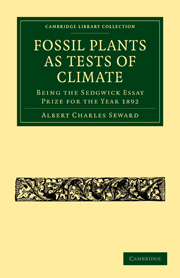Book contents
- Frontmatter
- PREFACE
- Contents
- Introduction
- Chapter I HISTORICAL SKETCH
- Chapter II PLANT DISTRIBUTION
- Chapter III PLANTS AND LOW TEMPERATURES: ARCTIC VEGETATION
- Chapter IV THE INFLUENCE OF EXTERNAL CONDITIONS UPON THE MACROSCOPIC AND MICROSCOPIC STRUCTURES OF PLANTS
- Chapter V ANNUAL RINGS IN RECENT AND FOSSIL PLANTS
- Chapter VI ARCTIC FOSSIL PLANTS
- Chapter VII CARBONIFEROUS PERIOD
- Chapter VIII PLEISTOCENE PLANTS AND CONCLUSION
- List of Works referred to in the Text
- Index
Chapter V - ANNUAL RINGS IN RECENT AND FOSSIL PLANTS
Published online by Cambridge University Press: 07 September 2010
- Frontmatter
- PREFACE
- Contents
- Introduction
- Chapter I HISTORICAL SKETCH
- Chapter II PLANT DISTRIBUTION
- Chapter III PLANTS AND LOW TEMPERATURES: ARCTIC VEGETATION
- Chapter IV THE INFLUENCE OF EXTERNAL CONDITIONS UPON THE MACROSCOPIC AND MICROSCOPIC STRUCTURES OF PLANTS
- Chapter V ANNUAL RINGS IN RECENT AND FOSSIL PLANTS
- Chapter VI ARCTIC FOSSIL PLANTS
- Chapter VII CARBONIFEROUS PERIOD
- Chapter VIII PLEISTOCENE PLANTS AND CONCLUSION
- List of Works referred to in the Text
- Index
Summary
The presence or absence of annual rings in fossil wood has been quoted as bearing directly upon the question of climates.
Witham was one of the first to notice the difference between Palæozoic, Mesozoic, and recent woods, as regards the degree of distinctness of rings of growth. Unger expresses the opinion that it is of importance for us to be familiar with the conditions which govern the formation of rings in living trees, in order that we may be the better able to speculate upon the significance of their presence or absence in fossil trees. Annual rings, says Unger, may be used as indicators (“Fingerzeig”) with regard to climatal conditions. In the Palæozoic Coniferous woods he describes the annual rings as entirely absent or very indefinite: they become much better marked in Keuper and Liassic Conifers, in the Oolitic woods still clearer, and in Tertiary times the wood of Conifers appears to have closely resembled that of recent trees. It is concluded from these facts that in the older periods there was no marked change in temperature during the year, not even such variations as now occur in the tropics. The term “annual ring” has come to be generally applied to the layer of tissues added every year by the activity of the cambium to the wood of a tree.
- Type
- Chapter
- Information
- Fossil Plants as Tests of ClimateBeing the Sedgwick Essay Prize for the Year 1892, pp. 77 - 89Publisher: Cambridge University PressPrint publication year: 2009First published in: 1892



